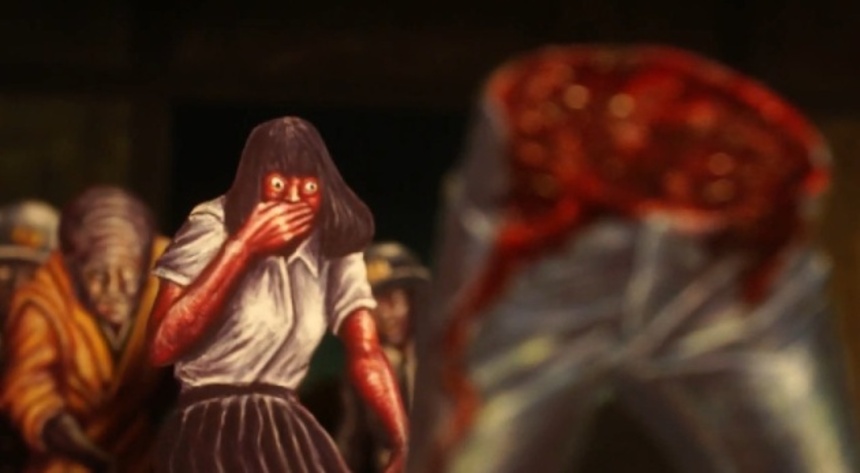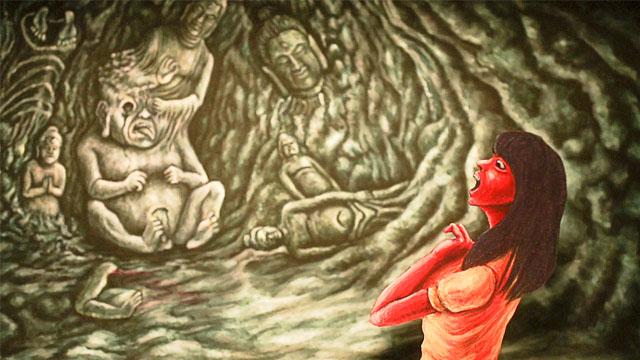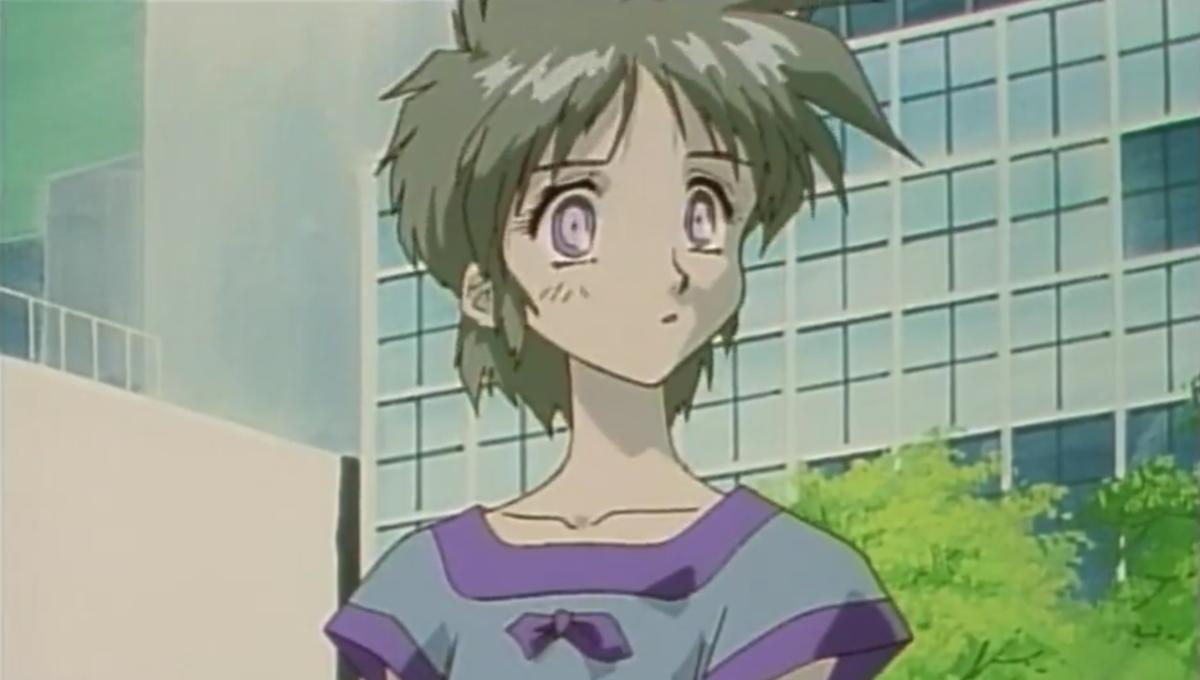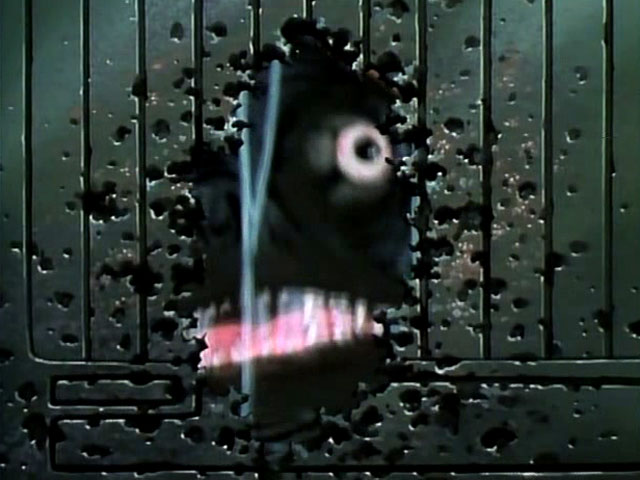Director: Hiroaki Satō
Screenplay: Hiroaki Satō
Voice Cast: Junko Iwao as Tokiko
"Key" Mima; Hiroshi Yanaka as Tomoyo Wakagi; Jūrōta Kosugi as Sergei
/ "D"; Miki Nagasawa as Sakura Kuriyagawa; Sho Hayami as Jinsaku Ajo;
Toshiyuki Morikawa as Shuuichi Tataki; Akio Ohtsuka as Aoi; Chiyako Shibahara
as Beniko Komori / Miho Utsuse
Viewed in Japanese with English Subtitles
If you look at Key the Metal Idol altogether, this was
such an ambitious and peculiarly project for the better. In anime, straight to
video work (OVAs) could be multiple episodes released on multiple videotapes; Key the Metal Idol took a huge risk
when at over fifteen episodes, it gives me wonder on what prices the viewers
would have paid for all the tapes1. Whatever the practical nature of
the release, this was at least an ambitious tale of androids and robots, idol
singing and conspiracy. The one catch to mention is that, after an initial set
of thirteen episodes which are structured at a usual anime TV length of twenty
five to thirty minutes, Key the Metal Idol eventually leads to two feature
length conclusions, which meant many drastic changes.
With the time available for
animation to be slicker than most television and for a more detailed plot than
OVAs which have significantly less time to play with, it layers on an odd mix
of science fiction, spirituality and all in the midst of a premise which
initially suggests robot idol singers. Whilst there are episode directors, the
chief director of the OVA is Hiroaki Sato, the animation director of the
legendary Akira (1988) who sadly
didn't helm much at all or even work in a lot of anime next to his peers, only
directing one other thing in Yoshimune
(2006), an utterly obscurity.
The titular Key herself is by all
accounts, least for most of the show, a robot girl created by Dr. Murao Mima. On his deathbed, he passes
on a message to his granddaughter Key she can become human by finding over
30,000 friends. Going to a metropolise, she encounters Sakura, who comes form
the same rural village, but also the Ajo Heavy Industries and Production Minos led
by Jinsaku Ajo, who are responsible for her grandfather's death ultimately and
happen to be ran by a madman, one whose corporation is later revealed to be
harvesting "gel" from unwilling victims, the homeless and their
enemies, the solidified life force of human beings used to power robots which
are remote controlled by people. In a curious plot choice, which is openly
known before the details mentioned above in the narrative, is that their best
way to test the robots is Miho, an idol singer who is actually remote
controlling a robot version of herself, a pawn kept by Ajo as a pet who
demonstrates some really creepy sexualised obsessions with robotics and playing
God. Key herself, unaware of any of this, upon discovering Miho considers,
despite being a timid and quiet figure, this the best director to find 30,000
people.
It's such an odd premise, if a
compelling one, one which hangs on a huge cultural aspect that exists in Japan of
idol singers. "Idols" don't necessarily have to be singers, but it's
the most commonly known version, manufactured icons for managers and talent agencies.
Idols have a dark underbelly too - they can be controlled by their management
even to the point of any concept of romance and personal lives, not to mention
that when it involves female idols (including teenagers) there's a really
uncomfortable aspect to consider in this too. Satoshi Kon's 1997 film Perfect
Blue was a fascinating take on this from the perspective of a member of an
idol trio who, trying to grow as an actress in a new career, lead to a
psychodrama which looked in the darker side of idol fan culture too. (And how
fitting, without realising the connection at first, that voice actress Junko Iwao, who plays Key, also voices
that idol singer protagonist in Perfect
Blue). Here, there's a perverse metaphor, whatever your opinions of various
idol groups and singers' managements, of a company who are literally
controlling women, making robot versions of them, and with Ajo going as far as
even assaulting their backup lead singers with violence or draining them emotionally
until they are on death's door constantly.
Another factor of significance is
that, in lieu to probably the original plan, the series until the final feature
length episodes drip feeds its plot and never really explains a lot towards the
final two pieces, which make up most of the OVA leaving many questions. Key
when she briefly turns human throughout the series, in emotionally intense
moments or in crowds, has incredible psychic powers. This leads to the
introduction of Prince Snake-Eye, a cult leader whose characterisation takes a
fascinating path, but to keep some secrets involves trying to sabotage Key's
idol singer career, and leads to her literally healing a child from near death,
which does raise some new issues at hand with who she is. The show, despite its
science fiction plot, jumps fully into spiritual themes, especially in Key's back-story
as a shrine maiden is a memory she has, from a curious slant as its going
eventually be interpreted through science fiction details.
There's also the inherent fact
that there's a very idiosyncratic attitude here to characterisation which at
first requires a lot to get used to, might even be perceived as wooden or
characters not actual like regular people, but I came to realise was
individuals on the production staff trying to actually write characters who
were more realistic even if it has to contrasts an inherently over-the-top
plot. The character of Sakura is the best example of this, a figure who bites
her tongue a lot despite having the brash and confidence attitude, one which
leads her to conflict with Key's apparent robotic nature and nursing a growing
affection for Shuichi Tataki, a handsome guy who is the head of the Miho fan
club who slowly begins to realise something is very amiss with the star. Even
the apparent villains have idiosyncrasies, figures having darker layers to
them, where even if he is the outright villain Ajo is a former World War II
veteran whose obsession with the opportunities with robotics became a violent
God like mania. The dance choreographer and general artistic talent Hikaru
Tsurugi, who is an abusive and cold man, is one of a figure distant to people,
who attaches himself to Key when he considers her like him. Even Ajo's right
hand man, a hulking former soldier named Sergi, is a man who thinks himself
smarter than his employee, a man who can literally be described as superhuman
but at a cost in his career of having becoming an addict to gel, which
considering its solidified human life force really has a curious undercurrent
meaning to it.
Complicating the series was that,
with the clear sense something happened in the production that forced the
creative team to work on these and release them in 1997, which they had to have
two feature length final episodes. Before,
not a lot of back story was explained, to which this means the first film is a
giant exposition dump, where it becomes quite obvious the original plan had to
be scrapped and this was the result. It's fascinating when you learnt the
context, reaching as far back as 1950s Japan back into the story's modern
setting in a web of characters like Key who get fully formed, but its sudden
and involves two characters having a long conversation in a park to explain
this all. A whole new character is even introduced just to add context to one
side even, so I would not in the slightest hold back any person, if they go out
to find this series, really has issues with episode fourteen, as it's such a
sudden lunge into so much plot detail, even if it gets into a lot of
fascinating material including a sub current theme of women being dominated by
men and the inherently horrifying nature of it.
The final episode does do a lot
though that succeeds after the fact, even against the obvious jarring change in
pacing. It ultimately reveals as well how sad the story really becomes - only
one major character dies in the whole OVA, but it's one you come to love, a
normal person, and it's treated with the immense sadness even if the others
have to move on quickly in dangerous circumstances. The result is one of the
best attempts at depicting a death bed scene or a death when anime can bungle
it so badly or, in the midst of an ultraviolent one, it just becomes a ghoulish
background noise. The series altogether, even when it may come off as
haphazard, does make the success of not pulling punches. Even when there are
some contrivances when characters might've reacted fasted, most of the series
thankfully has it there's a reason acts don't take place, like Sergi being too
injured to actually continue, that a location when finally learnt of is
immediately acted upon, or that it's known that, as the series progresses,
Key's unseen abilities even scare Ajo and his lackeys. The show doesn't hide
how dangerous the villain is, but there's reason to why he acts the way he
does, even if the explanation like using his own scientists for gel extraction
is the act of a lunatic. It is, in all honestly, a nuisance filled production that'll
develop layers if I revisit the whole series.
The show is also elusive and slow
burn for the better. I cannot help but think of the shadow of influence Neon Genesis Evangelion (1995-6) had on
this series and others as, whilst the OVA originally started in 1994 and is its
own unique creation, the ending of Key
the Metal Idol when it becomes a phantasmagorical head-trip, and a concert
hall is entirely filled with purple life force gel, feels like something that
could only exist after Neon Genesis
Evangelion, and the unleashing of The
End of Evangelion (1997) on Japanese cinema goers, took such strange and
surreal risks with anime. As a result of when this OVA start, it technically
doesn't belong to the school of unique and risky anime productions, mostly in
television, that Neon Genesis Evangelion
encouraged the creation of by being so popular, from Serial Experiments Lain (1998) to argubly the original Boogiepop Phantom series from the year
2000. I'd gladly put Key the Metal Idol
as a prototypical entry, not to suggest that there wasn't this type of
idiosyncratic animation before the mid nineties, but that as of yet my only
knowledge comes from it usually being in theatrical work or experimental anime.
The OVA market, when it first started in the early eighties, really helped the
encouragement of idiosyncratic productions. Key the Metal Idol is nonetheless a curious being even here as, due
to the structure, it's a lot longer than most OVAs I have encountered so takes
on the pacing and structure of a regular anime series2.
The OVA was created by Pierrot, a company whose track record
includes a lot of huge mainstream hits in anime, some like the Naruto franchise probably known even
outside of hardcore anime fan circles. A higher animation quality over TV is
here as there was significantly less restrictive time scales per episode
allowing for more. It also allowed for more mature content but its wisely used;
there's nudity, but its matter of fact, and the violence is not always there
but a sudden shock, surprising in how nasty it is whilst making sense as, if
there was a super powered robot involved in a scene, it could crush a human
head like a grape.
There's also a wonderful dark
mood, one which is helped by the richness of the style in colour and character
designs. Character designer Keiichi Ishikura's work is very idiosyncratic here,
which helps provide the show its own tone, and even if there's a lot of day
scenes, the style of Key the Metal Idol
can definitely be seen in its very rich use of dark colours and a very slow
burn pace. The main opening song is also beautiful,
a jazz pop ballad whose moody female vocals about lovesickness befit the show
perfectly. For a story where music is going to be of importance, it executes as
well the music and the visual depictions of performances with considerable
affect - the Miho performances, even the behind the scenes moments we see
throughout the story, have their own strangeness to them, anything from giant
unused plants to a robotic cello group among the artistic touches. And of
course, for anyone who has seen the show already reading this review, a huge
plot point involves a song called "Lullaby", initially a mere
incomprehensible mummer when Shuichi acquires it through his sources, but is
built towards with considering nuisance.
It's together a flawed but utterly
admirable piece for me, where even the aforementioned flaw (mainly the fourteen
episode) instead becomes part of its personality and thus no longer a
detraction for me after contemplating the show. This OVA series is something definitely
(sadly) not as well known despite having an English dub, licensed by a company
named Viz in 2000 for the American
market, although thankfully in 2017 another named Discotek released it in the United States again for DVD.
It's a series, honestly, that
should be more wider known beyond this, to which why I will also give credit to
Crunchyroll making the OVA series
available in Britain in 2019, the time when I saw the show. To not time stamp
this review, sadly a lot of Discotek
titles, or older anime in general even from the 2000s, were not as easily
accessible in the United Kingdom in 2019 as one would presume or hope,
dominated naturally by new titles advertised to bring forth revenue. One of Key the Metal Idol's virtues is good
old elegant hand drawn animation, and its time stamped by the era it comes from,
just in one of Sakura's night jobs being a videotape rental store, it is
nonetheless timeless because it's still a fascinating one off, something
difficult to categorise in terms of genre or expectations, whose presentation
is even idiosyncratic and eventually, yes, embraces the unconventional fully. That
kind of work, even outside of Japanese anime, I fall hard for.
=====
1) Of interest, considering how
anime has notoriously been too expensive
from what I have heard in terms for Japanese fans, price gouging to us Westerners
if we looked at the prices and in comparison to content, Key the Metal Idol may
have had its first episodes released at a significantly cheaper price if the
Wikepedia page is right. Sadly this is unsubstantiated information, without a
reference source, so I had to take this piece of the review out and warn you of
its potential falsity.
2) There have been longer OVA
works if you are curious. Legend of the Galactic
Heroes is probably the most famously long OVA work, starting in 1988 and
ending also in 1997, with its main series being over a hundred and ten
episodes. That's not including side stories, feature films and remakes.
